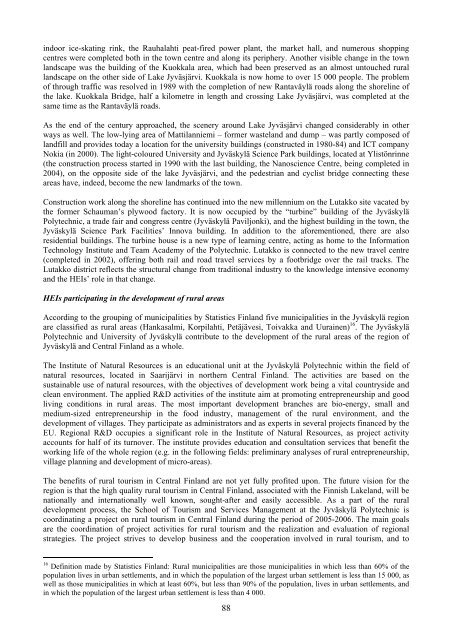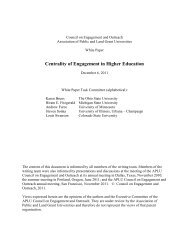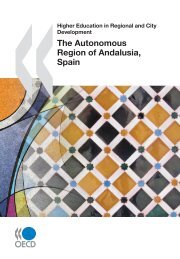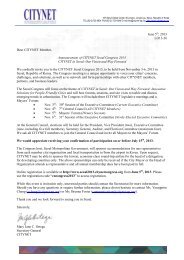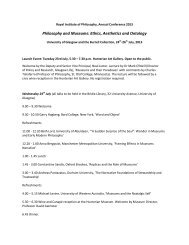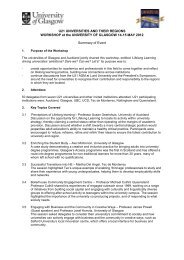The wellness sector is set to become a new pillar for the development of the Jyväskylä region. Thedevelopment of the wellness technology and associated services require a strong knowledge base. Researchand education in sports and health sciences – both mental and physical health – are firmly established in theJyväskylä region. Research and development are conducted by the University of Jyväskylä and the JyväskyläPolytechnic in health and sport sciences, occupational and physiotherapy, and gerontology. The palette iscomplemented further by the activities of Likes, a trust that promotes public health through sport, and KIHU,the Finnish Research Institute for Olympic Sports. An important unit at the University of Jyväskylä is thePsykocenter, a multidisciplinary networked research community concerned with human development, whichoperates in the Agora Centre. The regional effects of the development of the wellbeing sector might berealized through the establishment of new firms providing wellbeing services and different R&D projectscarried out in the region. The expansion of the wellness branch allows such things as an increasing provisionof services aimed at elderly people, the development of vocational wellness and properly functioning workcommunities.In the Jyväskylä region, in addition to the numerous recreational facilities accessible daily, there arenumerous lakes and forests where one enjoy the great outdoors. Sport is a visible part of the image ofJyväskylä; this is especially so as the Faculty of Sport and Health Sciences located in the University ofJyväskylä is the only one of its kind in <strong>Finland</strong>. The Department of Sport Sciences educates professionalsand experts in order to refresh and renew the professions in the field of sport and leisure activities. Thecontribution of students in promoting sporting activities among the wider population can be seen by theiractive participation in the organization of sporting events, work efforts as instructors in the regional sportssocieties, and public and private organizations for physical exercise (e.g., fitness centres). The Faculty ofSport and Health Sciences also cooperates with regional public sector authorities (e.g., Department of Sportsand Physical Activity of the city of Jyväskylä and the Sport Council of Central <strong>Finland</strong>).The contribution of HEIs to social development in the Jyväskylä region could be further strengthened byextending regional networks. A new promising field is gerontology, which aims at meeting the challenges ofan ageing population. Issues related to ageing, functional capacity and disability form the core of theresearch activities in this field. The main aim of this field is to understand age-related changes in the abilityto adapt to the relevant environmental requirements. The development and cooperation of HEIs is promotedby establishing GeroCenter, which brings together the different actors and their know-how in research,education, development, and the provision of services.The National Research and Development Centre for Welfare and Health (STAKES) established a regionalunit in Jyväskylä in autumn 2005. At an early stage, one of its main objectives was the development andevaluation of, and research into those social services operating in close cooperation with the HEIs,municipalities, Central <strong>Finland</strong>’s Centre of Expertise in the Social Field and other organizations. TheJyväskylä Polytechnic and University of Jyväskylä have great expectations for STAKES’ operations in theregion.Physical renewal of local milieuThe Seminaarinmäki campus of the university occupies a key role in the cultural history of the city ofJyväskylä. It forms an integral part of the city’s architecture and it has influenced the planning of the city.The oldest buildings date from the 1880’s. The buildings that comprise <strong>Finland</strong>’s first Finnish-languageteacher training college dating from 1880-1905 were designed by architects K. Kiseleff and Yrjö Blomstedt.The next phase of construction coincided with the granting of university status, at which time the variousbuildings designed by the world-famous architect Alvar Aalto were completed (1952-57, 1964, 1971). Thenewest buildings on the main campus are designed by architect Arto Sipinen and date from the 1970s. Anumber of private houses designed by the architect Wivi Lönn in the early 1900s have also been preserved inthe Seminaarinmäki area and restored in recent years to their former glory. The result is a uniquearchitectural whole in the heart of the city. Aalto’s campus became a protected area, including the buildings,in the Council of State protection declaration in 1992.The town area of Jyväskylä lies squarely between two lakes, Jyväsjärvi and Tuomiojärvi. The 1980s were adecade of powerful development in Jyväskylä. This was most evident in the form of new public buildings invarious parts of the town. This was a period when buildings such as the town library, the town theatre, the87
indoor ice-skating rink, the Rauhalahti peat-fired power plant, the market hall, and numerous shoppingcentres were completed both in the town centre and along its periphery. Another visible change in the townlandscape was the building of the Kuokkala area, which had been preserved as an almost untouched rurallandscape on the other side of Lake Jyväsjärvi. Kuokkala is now home to over 15 000 people. The problemof through traffic was resolved in 1989 with the completion of new Rantaväylä roads along the shoreline ofthe lake. Kuokkala Bridge, half a kilometre in length and crossing Lake Jyväsjärvi, was completed at thesame time as the Rantaväylä roads.As the end of the century approached, the scenery around Lake Jyväsjärvi changed considerably in otherways as well. The low-lying area of Mattilanniemi – former wasteland and dump – was partly composed oflandfill and provides today a location for the university buildings (constructed in 1980-84) and ICT companyNokia (in 2000). The light-coloured University and Jyväskylä Science Park buildings, located at Ylistönrinne(the construction process started in 1990 with the last building, the Nanoscience Centre, being completed in2004), on the opposite side of the lake Jyväsjärvi, and the pedestrian and cyclist bridge connecting theseareas have, indeed, become the new landmarks of the town.Construction work along the shoreline has continued into the new millennium on the Lutakko site vacated bythe former Schauman’s plywood factory. It is now occupied by the “turbine” building of the JyväskyläPolytechnic, a trade fair and congress centre (Jyväskylä Paviljonki), and the highest building in the town, theJyväskylä Science Park Facilities’ Innova building. In addition to the aforementioned, there are alsoresidential buildings. The turbine house is a new type of learning centre, acting as home to the InformationTechnology Institute and Team Academy of the Polytechnic. Lutakko is connected to the new travel centre(completed in 2002), offering both rail and road travel services by a footbridge over the rail tracks. TheLutakko district reflects the structural change from traditional industry to the knowledge intensive economyand the HEIs’ role in that change.HEIs participating in the development of rural areasAccording to the grouping of municipalities by Statistics <strong>Finland</strong> five municipalities in the Jyväskylä regionare classified as rural areas (Hankasalmi, Korpilahti, Petäjävesi, Toivakka and Uurainen) 16 . The JyväskyläPolytechnic and University of Jyväskylä contribute to the development of the rural areas of the region ofJyväskylä and Central <strong>Finland</strong> as a whole.The Institute of Natural Resources is an educational unit at the Jyväskylä Polytechnic within the field ofnatural resources, located in Saarijärvi in northern Central <strong>Finland</strong>. The activities are based on thesustainable use of natural resources, with the objectives of development work being a vital countryside andclean environment. The applied R&D activities of the institute aim at promoting entrepreneurship and goodliving conditions in rural areas. The most important development branches are bio-energy, small andmedium-sized entrepreneurship in the food industry, management of the rural environment, and thedevelopment of villages. They participate as administrators and as experts in several projects financed by theEU. <strong>Region</strong>al R&D occupies a significant role in the Institute of Natural Resources, as project activityaccounts for half of its turnover. The institute provides education and consultation services that benefit theworking life of the whole region (e.g. in the following fields: preliminary analyses of rural entrepreneurship,village planning and development of micro-areas).The benefits of rural tourism in Central <strong>Finland</strong> are not yet fully profited upon. The future vision for theregion is that the high quality rural tourism in Central <strong>Finland</strong>, associated with the Finnish Lakeland, will benationally and internationally well known, sought-after and easily accessible. As a part of the ruraldevelopment process, the School of Tourism and Services Management at the Jyväskylä Polytechnic iscoordinating a project on rural tourism in Central <strong>Finland</strong> during the period of 2005-2006. The main goalsare the coordination of project activities for rural tourism and the realization and evaluation of regionalstrategies. The project strives to develop business and the cooperation involved in rural tourism, and to16 Definition made by Statistics <strong>Finland</strong>: Rural municipalities are those municipalities in which less than 60% of thepopulation lives in urban settlements, and in which the population of the largest urban settlement is less than 15 000, aswell as those municipalities in which at least 60%, but less than 90% of the population, lives in urban settlements, andin which the population of the largest urban settlement is less than 4 000.88
- Page 1 and 2:
OECD/IMHE ‐ Supporting thecontrib
- Page 3 and 4:
SUMMARYTogether with 13 other regio
- Page 5 and 6:
8.2 Increasing the regional effecti
- Page 7 and 8:
I INTRODUCTION1.1 Strengthening the
- Page 9 and 10:
development. The aim is that region
- Page 11 and 12:
The self-evaluation considered here
- Page 13 and 14:
densely populated cities in Finland
- Page 15 and 16:
1,9 %1,7 %1,5 %1,3 %Population chan
- Page 17 and 18:
The share of jobs in primary produc
- Page 19 and 20:
New pillars of future’s developme
- Page 21 and 22:
Jyväskylä0,60,91,11,0Central Finl
- Page 23 and 24:
2.4 Governance StructureMunicipalit
- Page 25 and 26:
of its development outside the cent
- Page 27 and 28:
III CHARACTERISTICS OF THE HIGHER E
- Page 29 and 30:
continuing education and open unive
- Page 31 and 32:
The Science and Technology Policy C
- Page 33 and 34:
3.2 Regional dimension within the n
- Page 35 and 36:
order to respond to the challenges
- Page 37 and 38: 14001200Master's degreesDoctoratesN
- Page 39 and 40: 900800Youth graduatedAdult graduate
- Page 41 and 42: provide information for the basis o
- Page 43 and 44: CabinetParliamentSTPCSteering (andf
- Page 45 and 46: 5,04,0Billion euros3,02,01,00,083 8
- Page 47 and 48: The number of refereed articles is
- Page 49 and 50: Centre of expertisePaper industryBi
- Page 51 and 52: The Institute for Environmental Res
- Page 53 and 54: and systematic gradually progressin
- Page 55 and 56: are seen to be very important chann
- Page 57 and 58: Internal support units of HEIsThe F
- Page 59 and 60: of interviewed HEI staffs, the coop
- Page 61 and 62: areas of the region’s Centre of E
- Page 63 and 64: system of Jyväskylä and the HEIs
- Page 65 and 66: V CONTRIBUTION OF TEACHING AND LEAR
- Page 67 and 68: esources to establish new activitie
- Page 69 and 70: The main problem for the Finnish la
- Page 71 and 72: longer. 2.5% of the Jyväskylä Pol
- Page 73 and 74: activities. As a part of the new qu
- Page 75 and 76: education programmes consisting of
- Page 77 and 78: the TE-Centre of Central Finland an
- Page 79 and 80: practices in the provision of educa
- Page 81 and 82: Reason forskillupgradingDescription
- Page 83 and 84: Strengths+ HEIs are actively confro
- Page 85 and 86: taxation, to lower the unemployment
- Page 87: Box 6.2 The WIRE -projects: Support
- Page 91 and 92: The School of Cultural Studies at t
- Page 93 and 94: the number of registered customers
- Page 95 and 96: Box 6.9 Environmental management in
- Page 97 and 98: Strengths+ The significance of HEIs
- Page 99 and 100: eferring to the regional developmen
- Page 101 and 102: Key topics relating to changes in t
- Page 103 and 104: participation in the decision makin
- Page 105 and 106: in the strategy-making process. The
- Page 107 and 108: 7.5 Critical points in promoting th
- Page 109 and 110: 7.Cooperation in strategies concern
- Page 111 and 112: egion is according to national and
- Page 113 and 114: oundaries for further developmental
- Page 115 and 116: joining resources and operations by
- Page 117 and 118: Discussion proposal 15: To ensure d
- Page 119 and 120: achieved by the horizontal utilizat
- Page 121 and 122: Appendix 2 Information on data used
- Page 123 and 124: and finding synergy between the oth
- Page 125 and 126: School of BusinessRoleThe School of
- Page 127 and 128: The challenge of the school from re
- Page 129 and 130: developing wellness and environment
- Page 131 and 132: Faculty of EducationRoleThe Faculty
- Page 133 and 134: and/or graduation thesis is a signi
- Page 135 and 136: Areas of strength and prioritising
- Page 137 and 138: Agora Center’s partners from the
- Page 139 and 140:
Currently the priority of ITRI’s
- Page 141 and 142:
Weak spots and areas to develop in
- Page 143 and 144:
Employment and Economic Development
- Page 145 and 146:
Appendix 3 Analysis of the most sig
- Page 147 and 148:
Appendix 4 Regional effects (input-
- Page 149 and 150:
The overall value of production cre
- Page 151 and 152:
Appendix 5 Reform of regional struc
- Page 153 and 154:
Appendix 7 Provision of education i
- Page 155 and 156:
Appendix 8 Statistical information
- Page 157 and 158:
Appendix 10 Statistics on financing
- Page 159 and 160:
Appendix 12 Labour market activity
- Page 161 and 162:
Appendix 14 Master’s Programmes a
- Page 163 and 164:
Uusiutuvan energian tutkimusohjelma
- Page 165 and 166:
BIBLIOGRAPHYAcademy of Finland (200


